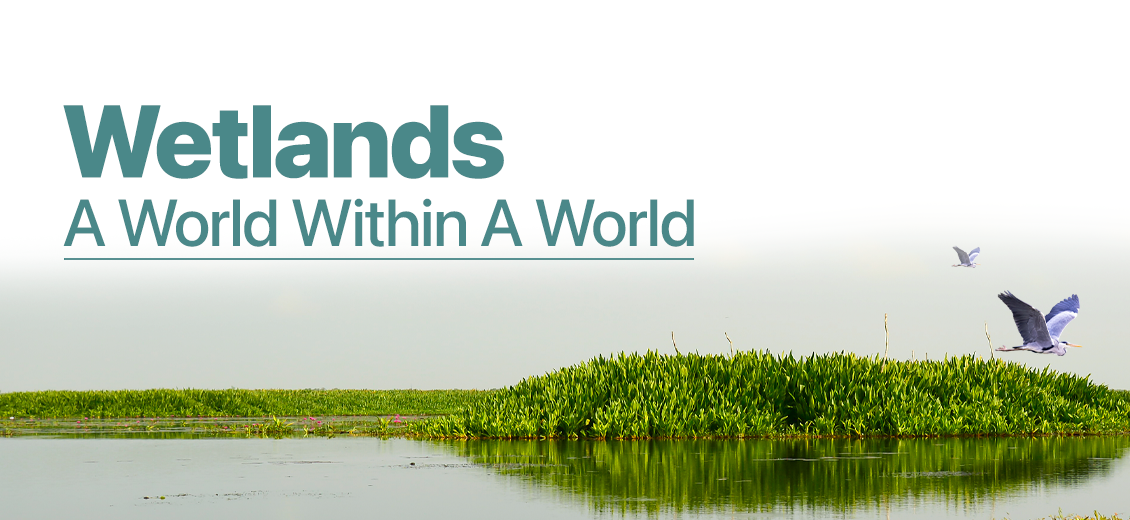Wetlands: A World Within A World
Blogs Home
- 02 Feb 2023

Wetlands are ecosystems that are characterized by their waterlogged soils and the presence of hydric plants. Wetlands are often overlooked and undervalued in our society, but they play a crucial role in maintaining a healthy and balanced ecosystem. These unique habitats are home to a diverse array of plant and animal species, and provide numerous benefits to both the environment and human populations.
Features of Wetlands
Some of the key features of wetlands include:
1. Hydrology: Wetlands are characterized by the presence of water, which can be either surface or ground water. They can be permanent or seasonal and can range from shallow ponds to deep marshes and swamps.
2. Soils: Wetlands have unique soil characteristics, such as hydric soils that are saturated with water for long periods of time. These soils are typically rich in organic matter and have a high capacity to hold water.
3. Vegetation: Wetlands are home to a diverse range of plant species, many of which are adapted to living in waterlogged conditions. These plants include reeds, rushes, sedges, and other marsh plants.
4. Fauna: Wetlands are also home to a wide variety of animal species, many of which are adapted to living in watery environments. These can include fish, amphibians, reptiles, birds, and mammals.
5. Hydrologic function: Wetlands act as natural sponges that can store water during floods and release it slowly during dry periods, reducing the risk of flooding and drought. They also help to purify water by filtering out pollutants and sediment.
6. Biodiversity: Wetlands are among the most biodiverse ecosystems on Earth, containing an incredible variety of plant and animal species.
7. Climate regulation: Wetlands act as carbon sinks and can help to mitigate the effects of climate change by storing large amounts of carbon in their soils.
8. Cultural significance: Wetlands have been an important source of food, medicine, and cultural identity for many indigenous communities, and have been a vital part of traditional livelihoods such as fishing and farming for generations.
The Significance of Wetlands
One of the most important roles of wetlands is their ability to act as natural water filters. Wetlands are able to remove pollutants and excess nutrients from water, making it cleaner and safer for both human and animal consumption. They also help to prevent flooding by absorbing and storing excess water, reducing the risk of damage to homes and infrastructure.
In addition to their water management capabilities, wetlands also serve as important habitats for a wide variety of plant and animal species. Many species of birds, fish, and other wildlife rely on wetlands for their survival. Some species, such as the American Bald Eagle, are even listed as threatened or endangered due to the loss of wetland habitats.
Wetlands also play a critical role in carbon sequestration, the process of absorbing and storing carbon from the atmosphere. Wetlands are able to store large amounts of carbon in their soil and vegetation, helping to mitigate the effects of climate change.
Despite their importance, wetlands are under threat from human development and land use changes. Many wetlands have been drained or filled in for development or agriculture, resulting in the loss of valuable habitats and ecosystem services. In addition, climate change is causing sea levels to rise, which is threatening coastal wetlands and the communities that depend on them.
The Cultural and Historical Significance of Wetlands
Wetlands are not only important for their ecological value, but also for their cultural and historical significance. For many indigenous communities, wetlands have been a vital source of food, medicine, and cultural identity for generations.
Fishing and hunting are traditional livelihoods that are closely tied to wetlands. Many indigenous communities rely on wetlands to provide fish and other aquatic animals that are a staple of their diet. In addition, wetlands also provide important resources such as reeds, rushes, and other plant materials that are used for building, crafting, and medicinal purposes.
Indigenous communities also have a deep spiritual connection to wetlands, which are often considered sacred places. Many traditional ceremonies and rituals are performed in wetlands, and they are often seen as places of healing and renewal. Wetlands are also an important source of traditional knowledge and wisdom, and many indigenous communities have a deep understanding of the ecological processes that take place in these ecosystems.
Sadly, many wetlands have been destroyed or degraded due to human activities such as urbanization, agriculture, and pollution. This has had a devastating impact on indigenous communities and their traditional livelihoods. It's crucial that we recognize the cultural and historical significance of wetlands and work to protect and preserve these important ecosystems for future generations.
Threats Facing Wetlands
Habitat destruction is one of the biggest threats facing wetlands. Human development and land use changes have resulted in the loss of wetland habitats around the world. Urbanization, agriculture, and resource extraction are all major drivers of wetland destruction. This destruction has resulted in the loss of critical habitats for a wide range of plant and animal species, as well as the degradation of ecosystem services provided by wetlands.
Pollution is another major threat facing wetlands. Polluted water, air, and soil can all have negative impacts on wetland ecosystems. Nutrient pollution, in particular, is a major concern for many wetlands. Excess nutrients, such as nitrogen and phosphorus, can cause algal blooms and other changes to the wetland environment that can harm plants and animals. Polluted water can also contain a wide range of toxic compounds that can harm or kill aquatic life.
Climate change is also having a major impact on wetlands. Rising temperatures and changes in precipitation patterns can alter the hydrology of wetlands and affect the distribution of plant and animal species. In addition, sea level rise is a major concern for coastal wetlands. As sea levels rise, saltwater can intrude into freshwater wetlands, altering their ecology and making them less suitable for many species.
How Wetlands can be Preserved?
To protect and preserve wetlands, it is important for individuals and communities to become more aware of the value and importance of these habitats. This can include supporting conservation efforts, promoting sustainable land use practices, and taking steps to reduce the impact of climate change.
- One of the most important is the creation of protected areas. Many wetlands around the world have been designated as protected areas, such as national parks and wildlife refuges, which help to preserve these ecosystems for future generations. In addition, many organizations and governments are working to restore degraded wetlands. This can involve removing invasive species, controlling pollution, and reintroducing native plant and animal species.
- One way to support wetlands conservation is to get involved in local conservation organizations or volunteer with wetland restoration projects. These organizations and projects often need help with monitoring and monitoring, seed collection, and invasive species removal.
- Another important step is to support sustainable land use practices. This can include supporting farmers and landowners who use sustainable farming practices that protect wetlands and their associated habitats. Additionally, it is important to support the development of green infrastructure, such as rain gardens and green roofs, which can help to reduce the impact of human development on wetlands.
- One of the most important things we can do to protect wetlands is to reduce our greenhouse gas emissions and slow the pace of climate change. This can involve reducing our use of fossil fuels, increasing our use of renewable energy, and taking steps to improve energy efficiency.
Wetlands are vital habitats that play a critical role in maintaining a healthy and balanced ecosystem. They provide numerous benefits to both the environment and human populations, including water management, habitat for a wide variety of plant and animal species, and carbon sequestration. Despite their importance, wetlands are under threat from human development and land use changes, as well as climate change. By becoming more aware of the value and importance of wetlands and taking steps to support their conservation, we can help to protect and preserve these vital habitats for future generations.
Aditi Saini
After pursuing Master's in Political Science from Indraprastha College for Women, Delhi University, she engrossed herself in Content Writing. Apart from being honest and a kind person, she is a good learner with the motto of "Live and let live".
Blogs Home




